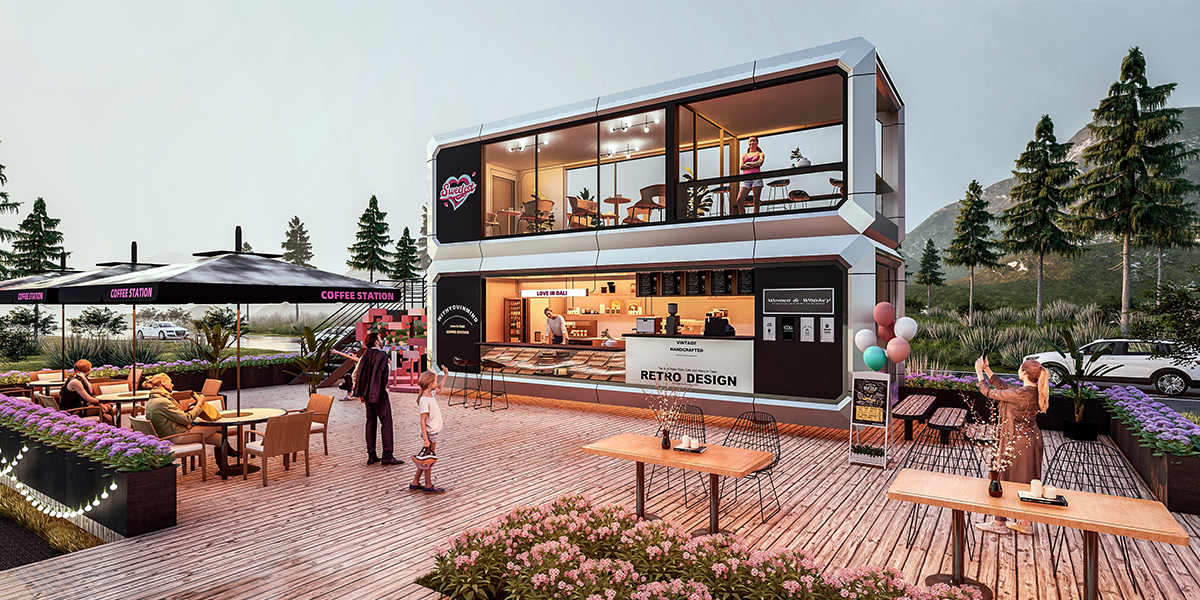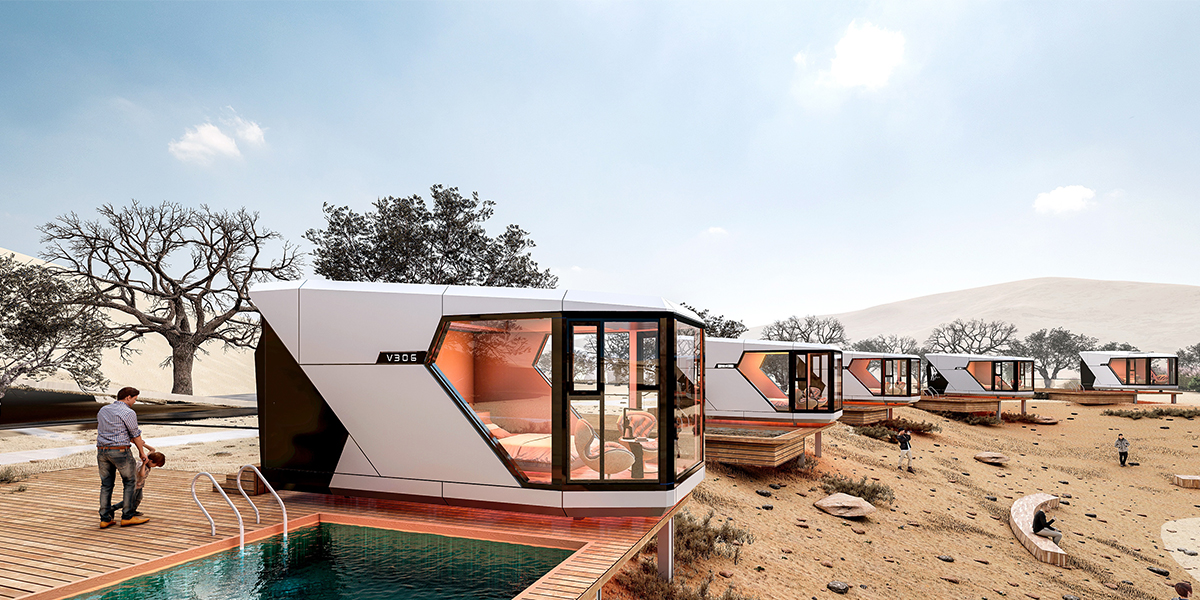
20 Jul Step-by-Step Guide to Setting Up a Prefab Capsule House in 2025
Table of Contents
Ready to learn about modern living? If you want to know how to set up a prefab capsule house, you are in the right spot. These homes have many good things:
You can pick your own layout and finishes.
They are smart and small, great for city life.
Reason | Why It Matters |
|---|---|
Good for the earth and makes less trash | |
Personalization | Made to fit what you like and need |
Minimalism | Simple and helps you live better |
You do not need to be an expert. This guide will help you with each step so you can enjoy your prefab capsule house. No worries, just good results.
Key Takeaways
Pick a good spot for your house. Set a budget that works for you. Make a checklist to help you save time and money.
Get all the needed permits early. Follow the building rules in your area. This helps you avoid delays and extra costs.
Make sure your site is ready. Build a strong and flat foundation. This keeps your house safe and steady for a long time.
Work with builders who know what they are doing. This helps your house arrive safely. It also makes assembly fast and connects utilities the right way.
Add smart features and design choices to your prefab capsule house. Make it fit your style and what you need.
Step-by-Step Guide
Planning
You want your prefab capsule house to feel cozy right away. Planning well makes things simple. First, think about the best place to put your house. Pick a spot with strong ground. Make sure it is close to roads, water, and power. Stay away from places that flood or have bad weather.
Here is an easy guide to help you plan:
Choose a spot that works for you and follows local rules.
Learn about the soil and weather in the area. This helps you pick the best way to build.
Check how near you are to water, electricity, and internet.
Think about how trucks and cranes will bring the modules. Make sure they can get to your land.
Plan where each room will go. Decide how you want your space to look and feel.
Set your budget. Remember to count land, building, permits, and finishing costs.
Make a checklist before you start. Write down every job, tool, and material you need.
Tip: A good plan saves you time and money. It also helps you avoid problems when building.
Permits & Codes
Before you build, you need to get the right permits. Every place has its own rules. Some places call capsule homes hotels. Others see them as houses. You may need a hotel license for short stays or a home permit for long stays.
Here is a table to show what you might need in different places:
Category | Key Requirements and Examples | Regions/Countries Example |
|---|---|---|
Legal Classification | Hotel license for short-term, residential rules for long-term, mixed-use permit for both | Tokyo, Paris, USA, Germany, Singapore |
Land Compliance | Zoning approval, community hearing, temporary use permit | San Francisco, London, Dubai |
Design Codes | Minimum room size, floor height, escape routes, structural standards | USA, EU, Japan |
Functional Facilities | Bathrooms, showers, public areas, kitchen fire safety | USA, Germany, Australia |
Material Requirements | Fireproof materials, wall thickness, eco-friendly coatings | USA, EU, Singapore |
Permit Steps | Architect drawings, structural reports, environmental review, approval cycle | USA, EU, Japan, China, UAE |
Fire Safety | Sprinklers, smoke detectors, emergency lighting, evacuation plans | USA, EU, UK |
Health/Public Health | Water testing, sewage permits, ventilation, AC cleaning | USA, EU, Germany, Australia |
Special Permissions | Accessibility, noise control, cultural compliance | USA, EU, Saudi Arabia, Malaysia |
You might face problems like zoning rules, size limits, or slow approvals. Talk to local officials early. Ask about all the permits you need. Make sure your plans follow safety and building rules. This helps you avoid waiting and extra costs.
Site Prep
Now you can start working on your land. Getting the site ready is very important. You need a safe, flat place for your prefab capsule house. Here is what you should do:
Pick a flat, strong spot that trucks and cranes can reach.
Clear away plants, rocks, and old roots. Take off the top soil if you need to.
Mark the edges with stakes and string. This shows where your house will go.
Dig and make the ground level. Check that the surface is flat.
Choose the best foundation. Use a concrete slab for flat land. Use pier and beam for slopes. Use screw piles for soft ground.
Build your foundation. Pour concrete, set beams, or put in screw piles.
Get your tools and safety gear. You will need hard hats, gloves, boots, and goggles.
Check your checklist again. Make sure you have all permits, materials, and instructions.
Note: Careful site prep keeps your house safe and strong for a long time. It also makes the rest of the build easier.
Foundation
 Foundation Setup
Foundation Setup
You want your prefab capsule house to last a long time. A strong foundation keeps your home safe and steady. If you skip this step, you might see cracks or shifting later. That is why you need to focus on the right foundation set-up before you start any construction.
There are a few types of foundations you can choose from. Each one works best for different land and weather. Here is a quick guide:
Foundation Type | Best For | Pros |
|---|---|---|
Concrete Slab | Flat, solid ground | Simple, strong, low cost |
Pier & Beam | Uneven or sloped land | Good for hills, easy repair |
Screw Piles | Soft or wet soil | Fast install, less digging |
You should talk to your builder or a local expert. They can help you pick the best option for your land. Always check the soil before you start the foundation set-up. Good soil means your construction will go smoother.
Tip: A solid foundation makes the rest of your construction much easier. You will save time and avoid big problems later.
Inspection
After you finish the foundation, you need to check it. This step is important in every construction project. Look for cracks, uneven spots, or water pooling. Use a level to make sure the surface is flat.
You may need a city inspector to visit your site. They will make sure your foundation meets all rules. If you find a problem, fix it before you move on. A good inspection now keeps your construction safe and strong.
Note: Never skip the inspection. It is your last chance to catch mistakes before you start building your capsule house.
Delivery & Installation
Transport
Getting your prefab capsule house to your site is a big step. You want everything to arrive safely and on time. Most companies use trucks or trains for local delivery. If you live far away or in another country, sea shipping is the top choice. Sometimes, if you need it fast and the house is small, air transport works, but it costs a lot.
Here’s how the process usually goes:
The company packs your house in strong steel frames or wooden crates. This keeps everything safe during the trip.
Movers who know prefab homes handle the loading and unloading. They use cranes for heavy parts.
The modular design lets them fit several units into one container. This saves space and helps the environment.
Before shipping, the team may take apart some sections to make transport easier and safer.
Tip: Make sure your road is wide enough for trucks and cranes. A solid foundation and clear path help avoid delays.
You pay for shipping to the nearest port. After that, you cover the cost of trucking, cranes, and local setup. Always check for damage when your house arrives. If you spot any problems, tell the movers right away.
On-Site Assembly
Now comes the exciting part—assembly! First, check that your foundation is ready and utilities like water and power are in place. The crew unloads the modules and uses cranes to set them on the foundation. They join the walls, floors, and roof with bolts or screws. This step goes fast because the pieces fit together perfectly.
Here’s a quick checklist for assembly:
Place each module in the right spot.
Connect the modules tightly.
Seal the joints to keep out water and wind.
Hook up plumbing, electricity, and internet.
Finish the inside with flooring, paint, and fixtures.
Manufacturers offer 24/7 support during assembly. If you have questions, you can call or chat with their team. They also help with decoration and smart home setup.
Install a Capsule House
When you install a capsule house, you might face a few bumps. Sometimes the ground is not level, or the weather slows things down. You can avoid most problems by planning ahead and working with skilled builders. Always double-check your permits and utility hookups before you start construction.
Note: A good assembly team and strong materials make your construction last longer and keep your home safe.
Utilities & Final Checks
Utility Connections
Now it’s time to get your prefab capsule house up and running. You need to focus on connecting utilities like water, electricity, sewage, and internet. Most prefab homes come with pre-installed pipes and wires, but you still need to link them to the main lines on your property. Sometimes, this step feels tricky, especially if your land sits far from city services.
Here’s a quick checklist for connecting utilities:
Water: Attach the main water line to your house’s inlet. Test for leaks.
Electricity: Connect the power cable to your breaker box. Make sure all outlets work.
Sewage: Link the drain pipe to the city sewer or your septic tank.
Internet: Run a cable from the street or set up a satellite dish.
Tip: Always double-check seals and waterproofing around the roof, windows, and doors. This keeps moisture out and protects your home.
One of the biggest challenges with connecting utilities is making sure every system works safely and smoothly before you move in. If you skip a step, you might face leaks, weak spots, or even power issues later.
Final Inspection
Before you settle in, you need a final inspection. Walk through your capsule house and look for anything out of place. Check the foundation for cracks or uneven spots. Test all the utilities again. Open and close every door and window to make sure they seal tight.
What to Check | Why It Matters |
|---|---|
Foundation | Keeps your house stable |
Ensures safe, easy living | |
Doors & Windows | Stops leaks and drafts |
Interior Finishes | Looks good and feels right |
A city inspector may visit to confirm everything meets local codes. This step gives you peace of mind and helps you avoid problems down the road.
Adjustments
After you pass the final inspection and adjustments, you might need to make a few small fixes. Prefab capsule houses often need custom stairs because every site is different. Use the plans from your builder to match the stairs to your land.
Here are some common adjustments: 1. Inspect the structure for cracks or gaps. 2. Test all utilities to confirm they work. 3. Check doors and windows for smooth movement. 4. Look at walls, floors, and ceilings for damage. 5. Tighten screws and add weatherstripping if needed.
Note: Taking care of these details now means you’ll enjoy a safer, more comfortable home for years to come.
Customization
Prefab Capsule House Options
You can make your prefab capsule house special. In 2025, most builders let you pick many things. Here are some top choices:
Pick the color you like for inside and outside walls.
Ask for special layouts or features with OEM options.
Add your own logo or design if you want it to stand out.
You can talk to the builder about modular construction upgrades. If you want a bigger kitchen or an extra room, you can add more modules. If you need less space, you can remove some. This makes your home fit your life as it changes. It is a smart way to plan ahead.
Tip: Customizing your home makes it match your style. It also makes it easy to change later.
Interior & Exterior
Prefab capsule house designs keep getting cooler. Here are some trends people like now:
Aspect | |
|---|---|
Exterior Design | Smooth, rounded shapes like pods or ovals. New materials like aluminum alloys and PVC fabrics. Big windows for more sunlight. |
Interior Design | Smart layouts with lots of storage. Simple lines and soft colors. Smart tech for lights, heat, and safety. |
You can pick finishes that fit your taste. If you want a bright space, choose big windows. If you like cozy, pick warm colors and soft lights. These choices help your home feel nice and look good.
Smart Features
Smart features make your life easier and safer. In 2025, you can add things like:
Smart locks to keep your home safe.
Home automation to control lights, heat, and appliances from your phone.
Sound insulation to keep things quiet.
Energy-saving systems with strong insulation to lower bills.
Air purifiers and smart toilets for comfort and health.
Electric curtains and skylights for easy light control.
You can use a control panel or your voice to manage everything. Modular construction lets you add new tech when you want. This keeps your home up-to-date and efficient.
Note: Good care tips are to check your smart systems often and clean filters to keep air fresh. Taking care of your home helps it last longer and stay green.
Prefab capsule houses use modular construction, so you can change or upgrade your space anytime. This design helps the planet by letting you reuse parts and make less waste. With the right care, your home stays safe, green, and ready for the future.
You now know how to set up your own prefab capsule house. Careful planning, following local rules, and checking every detail make the process smooth. If you want extra help, talk to a pro or look for more guides. Modular living brings real benefits:
Quality stays high with factory-built parts.
You help the planet by cutting waste.
You can change your space as your needs grow.
Enjoy your smart, modern home and the freedom it brings! 🏡
FAQ
How long does it take to set up a prefab capsule house?
You can move in fast! Most prefab capsule houses take 2 to 6 weeks from delivery to finish. Weather, permits, and site prep can change the timeline. Planning ahead helps you avoid delays.
Can I move my capsule house later?
Yes, you can! Capsule houses use modular designs. You can take them apart and move them to a new spot. Just make sure you have the right permits and a new foundation ready.
What maintenance does a prefab capsule house need?
You should check seals, clean filters, and test smart systems every few months. Look for leaks or cracks after storms. A quick checklist helps you keep your home safe and comfy.
Are prefab capsule houses safe in bad weather?
Prefab capsule houses use strong materials and smart designs. They can handle wind, rain, and snow. Always follow local building codes and ask your builder about extra safety features for your area.




 Foundation Setup
Foundation Setup